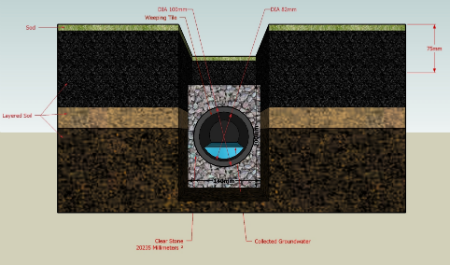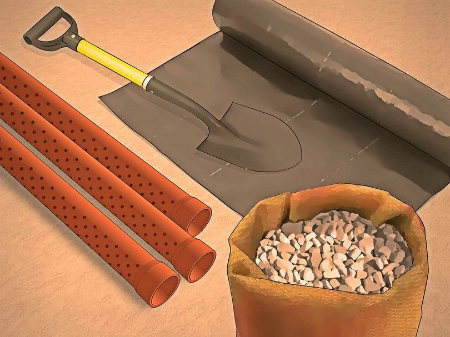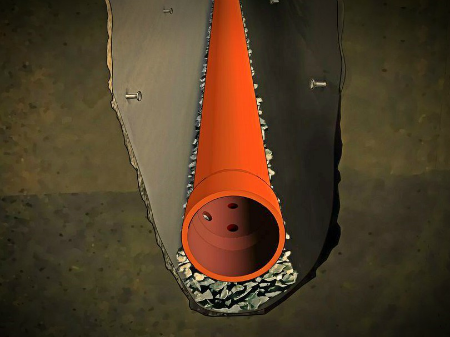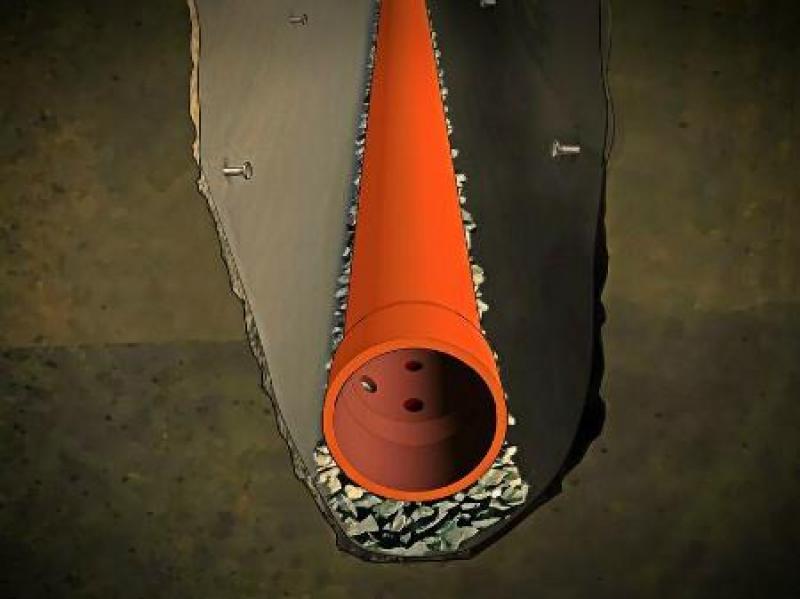What is a French Drain and How to Do It by Yourself?
by Scott Doyle on Nov 24, 2016
Being on terra firma means you need to pay special attention to ensuring your home is waterproof. One such method is the French drain, named after Henry Flagg French, a lawyer and former assistant U.S. treasury secretary from Concord, Massachusetts, who popularized the technique thanks to his book Farm Drainage (1859).
As a graduate of Dartmouth College and Harvard Law School, the French enjoyed more than just rules and regulations. He was an agriculture enthusiast and avidly experimented to increase scientific application to farming, particularly in the study of soil quality. The techniques used by farmers discussed in his published work, despite dating to nearly 160 years ago, still hold true today. The French drain is no exception.
Historical French drains were simply ditches, dug out from an area of elevation to lower ground, and filled in with gravel. At the time, French was constructing drains for his own farm and used roofing tiles in conjunction with a trench. Perforations were later added to these tiles with improvements in the process having been made over the years. French drains are now far more specialized than their predecessor, which is why they remain a popular waterproofing method for not only farmers, but homeowners too.
What is a French Drain and How Does It Work?
A French drain is simply a sloped trench that is lined with fabric with a pipe and gravel running through it. Its purpose is to steer water away from your home or other structures on your property.

Water naturally flows downhill, which is the route of least resistance. So during heavy rain, water will run into the gravel-filled trench before reaching the perforated pipe and flows through the pipe, away from your basement. The water is then emptied, whether it be on the street or in a drainage ditch.
A DIY French drain is quite easy. All it takes is a few materials: water-permeable landscape fabric, a perforated plastic drain, gravel or rock, and a shovel.

The process of building a French drain is not complicated, but careful attention is necessary. Work should begin on a downhill slope so that the trench can draw water away from your home just by the force of gravity. Before digging, think safety first. Locate any underground cables and pipes that run under the yard.
Then plan the route of your drain. Landscaping paint can help mark out the path. Make sure your runoff water doesn’t empty onto a neighbor’s land. Position it at least one meter away from walls and fences and steer clear of posts and plants like tree roots and shrubs. Depending on your municipality, digging may require paperwork. Consult your municipal office for information on the regulations about your neighborhood.
Once the above steps are completed, you can start digging your trench, the width and depth of which will depend on the severity of the drainage issue (consult with a professional). The standard size is about 15 centimeters (6 inches) wide and 46 to 61 centimeters (18 to 24 inches) deep. Hiring a surveyor or a professional specializing in waterproofing techniques to help with the planning stage is one way of ensuring you are on track.
Position the trench so that it is built on a downhill incline and regularly check you are digging in a downward direction. The trench is then lined with landscape fabric. Gravel is added, the pipe is fitted with the drain holes facing down and the opening covered.

At this point, you can be creative by adding a layer of decorative stones. Sometimes, people build their French drain at a slight curve to make the space look aesthetic.
Do You Need a French Drain?
This type of drain is an ideal solution for those with basements that are prone to flooding or have a soggy yard.
Basements: In this case, a deep French drain is recommended by professionals. With a trench running around the home’s perimeter, water is swiftly caught before flowing into your basement. Installation is also possible during and after home construction.
Yard: For an uneven yard, the drain does not need to be as deeply placed as in the case of wet basements. This type of French drain runs horizontally at a downhill inclination across the property.
Rain runoff, and many other waterlogged areas of your home.
From farmers to homeowners, the French drain has been lending a hand with water diversion for over 150 years. So whatever your waterproofing needs may be, when heavy rains wreak havoc on your basement or yard, this simple, yet effective solution can help. The issues that may surface with a DIY project can easily be mitigated with advice from a professional.
Popular Articles
Three Places to Spend Money on the Exterior of Your Home
When you have the exterior of your home remodeled, you are investing, time, energy and convenience into the project and you want to make sure that...
94923 Views
Homemade Headboards-Make an Upholstered or Wooden Headboard
Homemade headboards can add a lot of personality to any bedroom. They can be coordinated with existing furniture and room decor or they can be the...
74311 Views
When to Use a Brush, Roller or Sponge Brush
Brushes are a good choice for painting trim and woodwork. They are also useful for cutting in the edges around the top and bottom edges and corners...
71749 Views
Creating a Cottage Kitchen with Bead Board
Kitchen decor can range from modern and bold to elegant and elaborate by using strategic kitchen pieces. One of the most popular decorating trends...
52751 Views
Gas Fireplace Diagnostics and Troubleshooting
Follow these steps for diagnosing and troubleshooting Gas Fireplaces repairs. For the average DIYer, this may seem intimidating, depending on the...
30581 Views
Latest Articles
10 Concrete Patio Ideas on a Budget
A concrete patio can be a game-changer for your outdoor space. It is durable, versatile, and can be customized to fit your style. But what if you...
on Mar 25, 2025
Tips for Creating a Stunning Personalized Photo on Canvas
Order the unique beauty of a personalized photo on canvas and bring your memories to life. With a customized photo on canvas, you can transform...
on Mar 7, 2025
Best Areas to Buy Property in Singapore for Long-Term Growth
Singapore's real estate market remains one of the most stable and lucrative in the world. With limited land supply, strong governmental...
on Feb 18, 2025
Troubleshooting Excess Water in Your HVAC Secondary Condensate Drain Pan
When maintaining your air conditioning system, it is easy to overlook the condensate drain pan - until excess water starts pooling in places where...
on Jan 12, 2025
Real Estate Investment Trusts (REITs): A Beginners Guide
By combining the advantages of stock market and real estate investing, Real Estate Investment Trusts, or REITs, offer an alluring investment...
on Dec 19, 2024
Featured Articles
What Type of Licensed Contractor Should You Hire?
on Feb 28, 2017
Hire Contractors / Estimates

Looking for a specialty project? There are many types of contractors available for your home improvement needs. Finding the right type of...
Sponsored Articles
Best Areas to Buy Property in Singapore for Long-Term Growth
on Feb 18, 2025
Real Estate / Finance

Singapore's real estate market remains one of the most stable and lucrative in the world. With limited land supply, strong governmental...
Actions
Top Categories
- Garden / Landscaping / Patio — 264
- Kitchen / Bathrooms — 240
- Real Estate / Finance — 203
- Appliance / Repair — 186
- Interior Design / Decor — 184
- HVAC / Air Conditioning — 148
- Cleaning / Maintenance — 144
- Improvements / Remodeling — 131
- Plumbing / Basements — 118
- Floors / Tile / Hardwood — 116
- Doors / Garages — 113
- Safety / Security — 113
Articles Archive
More DIY Articles
Glass Tile History
Glass tiles have been present in interior design since the second century BC. There was a great demand for mosaic art in this period, contributing...
Plywood Thickness: Weight-Capacity Correlation
The thickness of plywood is essential in determining which to use for the intended purpose at hand. In general, most plywood only reaches 1 inch in...
A Few Things to Consider Before Hiring a Plumber
As a home owner you know that things break and wear out. Home plumbing repairs may require calling a professional plumber to help you solve your...
Five Cheap Ways to Make Your House Break-In Proof
While burglary isn't what it used to be, it's not completely gone either. Rates in Ireland have fallen dramatically, but there are still about...
3 Staircases to Add Style and Flair to Your Home
A beautiful home is beautified further by internal décor. Several small decisions, like a painter’s strokes, encapsulate and finally originate a...

